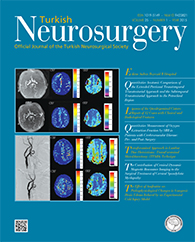2Ministry of Health, Fatih Sultan Mehmet Education and Research Hospital, Department of Neurosurgery, Istanbul, Turkey
3Ministry of Health, Oncology Education and Research Hospital, Department of Neurosurgery, Ankara, Turkey
4Ankara University, School of Medicine, Department of Histology and Embryology, Ankara, Turkey
5Yildirim Beyazit University, School of Medicine, Department of Histology and Embryology, Ankara, Turkey
6Ankara University, School of Medicine, Department of Neurosurgery, Ankara, Turkey DOI : 10.5137/1019-5149.JTN.10175-13.1 AIM: Bacitracin is one of the most frequently used agents for the topical irrigation of the cerebral cortex. The aim of this study is to investigate whether bacitracin has histopathological and ultrastructural effects when applied topically to the cerebral cortex.
MATERIAL and METHODS: Twenty-eight rats were randomly assigned to four groups. Except the control group, each rat underwent left frontoparietal craniectomy with dural removal. Then, in the sham group a piece of dry absorbable gelatin sponge was placed over the left hemisphere; in the saline group a gelatin sponge soaked in normal saline; and in the bacitracin group a gelatin sponge soaked in 500 units bacitracin was used. After 48 hours, brain tissues were extracted for histopathological and electron microscopic analyses.
RESULTS: Among the four groups dark stained neurons were found to be statistically higher in number in the bacitracin group compared with the control, sham and saline groups. Electron microscopic evaluation revealed that, in the bacitracin group, almost all cytoplasmic organelles were poorly preserved.
CONCLUSION: Topical application of the bacitracin on to the cerebral cortex caused histopathological and ultrastructural changes in the neural tissue. These changes may be an evidence for the neurotoxic effects of bacitracin.
Keywords : Bacitracin, Cerebral cortex, Neurotoxicity, Neurosurgery, Rat, Topical




